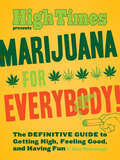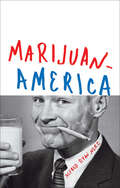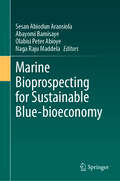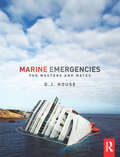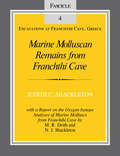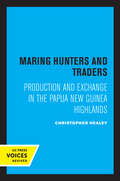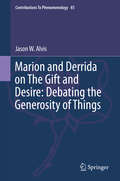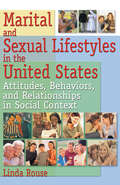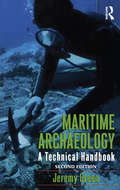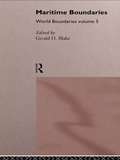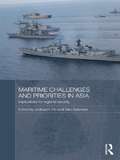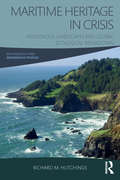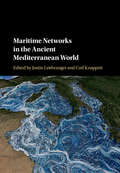- Table View
- List View
Marijuana Success Indoors
by Ed RosenthalMarijuana Success Indoors looks into the gardens of real people to see how they have combined gardening skill with technological savvy to produce quality buds. This large-format, 8.5 x 11 inch book focuses on homegrowing cultivation issues and solutions, including working in small spaces, the use of hydroponics versus planting mix gardens, lighting, and supplementing with CO2. A great companion to information found in grow guides Marijuana Success Indoors shows what types of problems are encountered in actual gardening situations, and how they are addressed to result in success.
Marijuana Success Indoors: Garden Tours and Tips
by Ed RosenthalMarijuana Success Indoors looks into the gardens of real people to see how they have combined gardening skill with technological savvy to produce quality buds. This large-format, 8.5 x 11 inch book focuses on homegrowing cultivation issues and solutions, including working in small spaces, the use of hydroponics versus planting mix gardens, lighting, and supplementing with CO2. A great companion to information found in grow guides Marijuana Success Indoors shows what types of problems are encountered in actual gardening situations, and how they are addressed to result in success.
Marijuana for Everybody!: The Definitive Guide to Getting High, Feeling Good, and Having Fun
by Elise McDonough High Times“A surprisingly deep guide to pot culture . . . 192 pages of legit knowledge” from the author of The Official High Times Cannabis Cookbook (The Cannabist).Marijuana is more widely available and accepted than ever before, with more people coming to the plant every day for a range of reasons. From the experts at High Times magazine—the world’s most trusted name when it comes to getting stoned—here is an authoritative, accessible guide to marijuana, its uses, and culture. This illustrated handbook offers clear and friendly primers on subjects such as what pot is and how it works, tips on getting high and managing the experience, cooking with pot, and FAQs as well as an “I’m High, Now What?” selection of activities and amusements for the freshly baked. Part manifesto, part party invitation, Marijuana for Everybody! is an informative and entertaining read for the uninitiated and practiced users alike.“The rapidly advancing world of weed gets broken down into easy chunks on topics like ‘cannabis chemistry,’ ‘how to: roll the classic cone,’ and ‘where do bongs come from?’ . . . The list-lovers will dig: 8 items to look for on the label when you buy legal weed; 6 things to do if you think you’re too high; 7 things to keep in mind when buying edibles; and 10 common marijuana strains and their characteristics.” —Smell the Truth“Well-written, carefully researched and incredibly thorough . . . If you have even a passing interest in marijuana, start clearing a space between your grinder and bong for this book on your coffee table.” —Willamette Week
Marijuanamerica: One Man's Quest To Understand America's Dysfunctional Love Affair With Weed
by Alfred Ryan Nerz“A delightfully weird . . . journey that includes crazed pharmacists, a guy named Buddha Cheese, and an interstate road trip with a trunk full of pot.” —A. J. Jacobs, New York Times–bestselling authorAlfred Ryan Nerz is a Yale-educated author, journalist, and TV producer. He’s also a longtime marijuana enthusiast who has made it his mission to better understand America’s long-standing love-hate relationship with our favorite (sometimes) illegal drug. His cross-country investigation started out sensibly enough: taking classes at a cannabis college, hanging out with a man who gets three hundred pre-rolled joints per month from the federal government, and visiting the world’s largest medical marijuana dispensary. But his journey took an unexpected turn and he found himself embedded with one of the largest growers and dealers on the West Coast. He quickly transformed into an underworld apprentice—surrounded by pit bulls, exotic drugs, beanbags full of cash, and trunks full of weed. But while struggling to navigate the eccentric characters and rampant paranoia of the black market, he maintained enough equanimity to explore a number of vital questions: Is marijuana hurting or helping us? How is it affecting our lungs, our brains, and our ambitions? Is it truly addictive, and if so, are too many of us dependent on it? Should we legalize it? Does he need to quit? As entertaining as it is illuminating, Marijuanamerica is one man’s attempt to humanize the myriad hot-button topics surrounding the nation’s obsession with weed, while learning something about himself along the way.“These wacky accounts rival T.C. Boyle’s fine novel Budding Prospects in showing the highly misguided paranoia that can be cured—or accentuated—by consumption of the marijuana plant’s sticky blossoms.” —Pasatiempo
Marine Bioprospecting for Sustainable Blue-bioeconomy
by Naga Raju Maddela Sesan Abiodun Aransiola Olabisi Peter Abioye Abayomi BamisayeThis volume comprehensively discusses marine bioprospecting and its applications in the marine bioeconomy, specifically in clean energy generation, and in biomedical, industrial and agricultural sectors. The advent of modern technology, particularly advancements in deep-sea exploration and biotechnology, has enabled scientists to delve deeper into the ocean's depths and discover a treasure trove of unique organisms and compounds. This demonstrates that the rich history of human interactions with the oceans is firmly ingrained in marine bioprospecting. The blue-economy, which is a more accurate name for the systematic search for valuable substances and organisms in the water, has gained popularity in recent years as a possible route for sustainable economic development. One of the key driving factors behind marine bioprospecting is the growing realization that marine organisms possess unique biochemical compounds with the potential to revolutionize various industries. These compounds include novel enzymes, antimicrobial agents, bioactive molecules, and even potential pharmaceuticals. Readers will learn about the applications of these discoveries in bioremediation, wastewater treatment, and biofuel production, as well as the identification of natural substitutes for things that are detrimental to the environment, which include biodegradable plastics derived from marine microorganisms. The primary audience for the book will be governmental and international organizations, professionals, and economists, while the secondary audience will be professors and researchers in the fields of Chemistry, Biotechnology, Environmental Microbiology, and general Ocean Sciences.
Marine Cargo Operations
by Robert J. MeurnMarine Cargo Operations clearly spells out the basic principles of cargo operations and acquaints merchant officers with the techniques of stowage and their application. Based on the authors’ half century of experience, the book singles out the most practical methods, procedures, and philosophies and presents them in thorough detail. Each discussion is enhanced by photographs or drawings. The book provides a complete understanding of the shipping cycle so all associated personnel can work as a team in observing the “three Cs” of shipping: communication, cooperation, and coordination. The third edition emphasizes containerization and the responsibilities of the ship’s officers for the proper and safe carriage of their cargo. The chapter on cargo responsibility has been updated by an admiralty lawyer, and a new chapter, “Stowage of Containers,” has been written by a ship’s master with thirty years of containership experience. The National Cargo Bureau furnished a chapter on stowage of grain bulk cargo. Also included are discussions on breakbulk cargo and how the ship’s officer can prevent condensation or moisture damage, the most common cause of cargo damage claims. This edition provides vital information and questions and answers for candidates taking a U.S. Merchant Marine license examination, and is an important refresher for those who have already received their licenses.
Marine Emergencies: For Masters and Mates
by David HouseAn influential guide to maritime emergencies and the current strategies that can be employed to cope with the immediate after effects and ramifications of disaster at sea. Many mariners will at some point in their maritime careers become involved in one sort of emergency or another, while in port or at sea, whether it is a fire on board, a collision with another vessel or an engine failure threatening a lee shore. Actions to take in such incidents can be the difference between survival and catastrophic loss. This text provides a direct insight into some of the latest incidents and includes: case studies from emergencies worldwide checklists and suggestions for emergency situations. everything from fire and collision right through to the legal implications of salvage. David House has now written and published eighteen marine titles, many of which are in multiple editions. After commencing his seagoing career in 1962, he was initially engaged on general cargo vessels. He later experienced worldwide trade with passenger, container, Ro-Ro, reefer ships and bulk cargoes. He left the sea in 1978 with a Master Mariner's qualification and commenced teaching at the Fleetwood Nautical College. He retired in 2012 after thirty three years of teaching in nautical education. He continues to write and research maritime aspects for future works.
Marine Molluscan Remains from Franchthi Cave: Fascicle 4, Excavations at Franchthi Cave, Greece (Excavations at Franchthi Cave, Greece #No. 4)
by Judith C Shackleton... the archaeological and paleoenvironmental data from Franchthi Cave are unique in providing a site-specific record of the cultural responses to great environmental changes." —Quarterly ResearchThe marine molluscan material covered here is the largest sample of its kind yet excavated in Greece.
Marine Tourism: Development, Impacts and Management (Routledge Advances in Tourism)
by Mark OramsMarine Tourism examines both successful and unsuccessful tourism in coastal and marine environments. The author provides an overview of the history, development and growth of marine tourism and describes the characteristics of 'marine tourists' and the 'vendors' of these tourist activities. The book includes case studies of specific types of tourism including:* the cruise ship industry, * whale and dolphin watching,* yachting - the America's Cup,* personal water crafts and other water sports* and maritime museums and festivals. in locations including Brighton, UK, the Florida Keys and Hawaii, USA Caribbean islands, New Zealand and Australia's Great Barrier Reef. The final section examines tourism impacts on marine ecosystems and coastal communities and explores management techniques aimed at reducing negative impacts and maximizing the benefits of marine tourism.
Maring Hunters and Traders: Production and Exchange in the Papua New Guinea Highlands (Studies in Melanesian Anthropology #8)
by Christopher HealeyThis title is part of UC Press's Voices Revived program, which commemorates University of California Press’s mission to seek out and cultivate the brightest minds and give them voice, reach, and impact. Drawing on a backlist dating to 1893, Voices Revived makes high-quality, peer-reviewed scholarship accessible once again using print-on-demand technology. This title was originally published in 1990.
Mario Lanza: Singing to the Gods (American Made Music Series)
by Derek ManneringBlessed with one of the great tenor voices of all time, Mario Lanza (1921-1959) rose to spectacular heights in a film, recording, and concert career that spanned little more than a decade. Groomed at the outset for a career on the opera stage, Lanza instead flourished in Hollywood where his films, most notably The Great Caruso, broke box-office records the world over and influenced the careers of countless musicians. To this day, the Three Tenors cite him as an inspiration for their own careers on the classical stage. Lanza's recordings for RCA sold in the millions, and he remains the crossover artist supreme. But his tremendous success was derailed by his self-destructive lifestyle, and by age thirty-eight he was dead, with his extraordinary promise left unfulfilled. Newly revised and updated for its first U.S. edition, Mario Lanza: Singing to the Gods is the definitive account of the remarkable life and times of one of the twentieth century's most beloved singing stars. This richly detailed work also contains a selection of rare photographs, several of which are drawn from Lanza's estate. With the support of Lanza's daughter, Ellisa Lanza Bregman, the tenor's colleagues, and his closest friend, Terry Robinson, Derek Mannering has chronicled a fascinating and unforgettable life. From the fabulous successes of the early MGM years through the disastrous walkouts and cancellations that sent Lanza's career into freefall, Mannering objectively and movingly reveals the story of a great star torn apart by his own troubled psyche and undisciplined lifestyle.
Marion and Derrida on The Gift and Desire: Debating the Generosity of Things
by Jason W. AlvisThis book examines the various encounters between Jean-Luc Marion and Jacques Derrida on "the gift," considers their many differences on "desire," and demonstrates how these topics hold the keys to some of phenomenology's most pressing structural questions, especially regarding "deconstructive" approaches within the field. The book claims that the topic of desire is a central lynchpin to understanding the two thinkers' conflict over the gift, for the gift is reducible to the "desire to give," which initiates a turn to the topic of "generosity. " To what degree might loving also imply giving? How far might it be suggested that love is reducible to desire and intentionality? It is demonstrated how Derrida (the generative "father" of deconstruction) rejects the possibility of any potential relation between the gift and desire on the account that desire is bound to calculative repetition, economical appropriation, and subject-centered interests that hinder deconstruction. Whereas Marion (a representative of the phenomenological tradition) demands a unique union between the gift and desire, which are both represented in his "reduction to givenness" and "erotic reduction. " The book is the first extensive attempt to contextualize the stark differences between Marion and Derrida within the phenomenological legacy (Husserl, Heidegger, Kant), supplies readers with in-depth accounts of the topics of the gift, love, and desire, and demonstrates another means through which the appearing of phenomena might be understood, namely, according to the generosity of things.
Marisol and Other Plays
by José RiveraThe first collection of plays by one of the most moving and astonishing writers of the last 15 years. Though critics reflexively class his work as "magical realism," Rivera's extravagant, original imagery always serves to illuminate the gritty realities and touching longings of our daily lives. Also includes: Each Day Dies with Sleep and Cloud Tectonics.
Marital Conflict and Children
by Patrick Davies E. Mark CummingsFrom leading researchers, this book presents important advances in understanding how growing up in a discordant family affects child adjustment, the factors that make certain children more vulnerable than others, and what can be done to help. It is a state-of-the-science follow-up to the authors' seminal earlier work, Children and Marital Conflict The Impact of Family Dispute and Resolution. The volume presents a new conceptual framework that draws on current knowledge about family processes; parenting; attachment; and children's emotional, physiological, cognitive, and behavioral development. Innovative research methods are explained and promising directions for clinical practice with children and families are discussed.
Marital Cruelty in Antebellum America (Conflicting Worlds: New Dimensions of the American Civil War)
by Robin C. SagerIn Marital Cruelty in Antebellum America, Robin C. Sager probes the struggles of aggrieved spouses shedding light on the nature of marriage and violence in the United States in the decades prior to the Civil War. Analyzing over 1,500 divorce records that reveal intimate details of marriages in conflict in Virginia, Texas, and Wisconsin from 1840--1860, Sager offers a rare glimpse into the private lives of ordinary Americans shaken by accusations of cruelty. At a time when the standard for an ideal marriage held that both partners adequately perform their respective duties, hostility often arose from ongoing domestic struggles for power. Despite a rise in the then novel expectation of marriage as a companionate relationship, and even in the face of liberalized divorce grounds, marital conflicts often focused on violations of duty, not lack of love. Sager describes how, in this environment, cruelty was understood as a failure to fulfill expectations and as a weapon to brutally enforce more traditional interpretations of marital duty. Sager's findings also challenge historical literature's assumptions about the regional influences on violence, showing that married southerners were no more or less violent than their midwestern counterparts. Her work reveals how definitions and perceptions of cruelty varied according to the gender of victim and perpetrator. Correcting historical mischaracterizations of women's violence as trivial, rare, or defensive, Sager finds antebellum wives both capable and willing to commit a wide variety of cruelties within their marriages. Her research provides details about the reality of nineteenth-century conjugal unions, including the deep unhappiness buried within them.
Marital Separation and Lethal Domestic Violence
by Carrie Smith Desmond Ellis Noreen StucklessThis book is the first to investigate the effects of participation in separation or divorce proceedings on femicide (murder of a female), femicide-suicide, homicide, and suicide. Because separation is one of the most significant predictors of domestic violence, this book is exclusively devoted to theorizing, researching, and preventing lethal domestic violence or other assaults triggered by marital separation. The authors provide evidence supporting the use of an estrangement-specific risk assessment and estrangement-focused public education to prevent murders and assaults. This information is needed not only by instructors in criminal justice and sociology programs, but by researchers theorizing about or investigating domestic violence. In the world of practitioners, family court judges, divorce mediators, family lawyers, prosecutors involved in bail hearings, shelter staff, and family counselors urgently need this resource. Ellis et al. include discussion questions and chapter objectives to support learners in the classroom or in community-based settings, and instructor support material includes PowerPoint lecture slides, additional teaching and research resources, and a test bank. This text advocates convincingly for prevention of domestic violence, and gives academics and practitioners the tools they need. This text advocates convincingly for prevention of domestic violence, and gives academics and practitioners the tools they need.
Marital and Sexual Lifestyles in the United States: Attitudes, Behaviors, and Relationships in Social Context
by Linda P RouseLearn the changing role of sexuality in American life!This helpful book offers a solid background in the sociology of family life and personal sexuality. Marital and Sexual Lifestyles in the United States: Attitudes, Behaviors, and Relationships in Social Context is designed to give readers a broad view of the diversity of contemporary U. S. attitudes, behaviors, and relationships. It also covers basic sociological concepts and research methods. Most human sexuality texts focus on the individual, whereas texts designed for sociology courses on the family downplay individual sexual expression. Marital and Sexual Lifestyles in the United Statesintegrates the two approaches. The choices of the individual take on additional meaning when seen within a unified historical, statistical, and conceptual framework.Marital and Sexual Lifestyles in the United States gives readers the tools to consider such pressing issues as: Does the divorce rate mean that the institution of marriage is in trouble? Are children's futures impaired if they come from single-parent households? Should same-sex couples be allowed to marry? How does marriage differ from cohabitation? What are the real sexual differences between the genders? What is sexual morality? How much confidence can we place in studies of human sexuality by such social scientists as Alfred Kinsey and Masters and Johnson?These questions and others like them are placed in the context of U. S. social trends, beginning with the 1950s and moving toward today. Plentifully illustrated with tables, charts, and figures that show where we are going as well as where we have been, Marital and Sexual Lifestyles in the United States gives a clear perspective on relationships in social context.
Maritime Archaeology: A Technical Handbook, Second Edition
by Jeremy GreenJeremy Green's systematic overview of maritime archaeology offers a step-by-step description of this fast-growing field. With new information about the use of computers and Global Positioning Systems, the second edition of this handbook shows how to extract as much information as possible from a site, how to record and document the data, and how to act ethically and responsibly with the artifacts. Treating underwater archaeology as a discipline, the book demonstrates how archaeologists, "looters," academics, and governments interact and how the market for archaeological artifacts creates obstacles and opportunities for these groups. Well illustrated and comprehensive in its approach to the subject, this book provides an essential foundation for everybody interested in underwater environments, submerged land structures, and conditions created by sea level changes.
Maritime Boundaries: World Boundaries Volume 5 (World Boundaries Series #Vol. 5)
by Gerald H. BlakeThe global political map is undergoing a process of rapid change as former states disintegrate and new states emerge. At sea, boundary delimitation between coastal states is continuing unabated. These changes could pose a threat to world peace if they are not wisely negotiated and carefully managed. Maritime Boundaries presents a variety of cases illustrating the implications of recent approaches to maritime territorial juristiction.
Maritime Challenges and Priorities in Asia: Implications for Regional Security (Routledge Security in Asia Pacific Series)
by Sam Bateman Joshua H. HoMaritime issues are particularly important for Asian countries, where there is a high reliance on shipping routes for international trade, many difficult disputes over maritime boundaries, and the prospect of increasing tensions where maritime power might play a significant role. This book uses contributions by 17 experts to build a comprehensive survey of the maritime issues affecting Asia. It discusses the issues overall, goes on to examine the issues from the perspective of each of 14 key countries, and concludes by assessing the prospects for resolving common problems in order to preserve good order at sea.
Maritime Crime and Policing (Routledge Frontiers of Criminal Justice)
by Martin Wright Yarin EskiThis book offers a unique and scholarly perspective on a little-studied subject: maritime crime and policing. The seas and oceans cover 70 percent of the earth’s surface and 90 percent of world trade by volume travels by sea. Furthermore, the refugee crisis has produced an inflow of people attempting to find a better life, particularly in Northwest Europe and the UK, which has had an impact on the maritime domains of European ports. While there has been attention paid to the role of maritime policing by scholars in maritime security studies, little attention has been paid by criminologists and policing studies scholars. This book aims to fill this gap. Bringing together a range of international scholars, this book covers a variety of topics pertinent to maritime crime and its policing, such as fraud, piracy and armed robbery at sea, illegal and unregulated fishing, smuggling, people trafficking, illegal immigration, illegal dumping and pollution, arms trafficking, terrorism, and cargo theft. It brings together new perspectives on several key criminological themes such as transnational organised crime, criminalisation, and securitisation and provides a bold new direction for the landlocked discipline of criminology and policing studies. An accessible and compelling read, this book will be of interest to students and scholars of criminology, policing, sociology, politics, migration studies, and all those interested in the policing of the sea.
Maritime Heritage in Crisis: Indigenous Landscapes and Global Ecological Breakdown (Archaeology and Indigenous Peoples)
by Richard M. HutchingsGrounded in critical heritage studies and drawing on a Pacific Northwest Coast case study, Maritime Heritage in Crisis explores the causes and consequences of the contemporary destruction of Indigenous heritage sites in maritime settings. Maritime heritage landscapes are undergoing a period of unprecedented crisis: these areas are severely impacted by coastal development, continued population growth and climate change. Indigenous heritage sites are thought to be particularly vulnerable to these changes and cultural resource management is frequently positioned as a community’s first line of defense, yet there is increasing evidence that this archaeological technique is an ineffective means of protection. Exploring themes of colonial dislocation and displacement, Hutchings positions North American archaeology as neoliberal statecraft: a tool of government designed to promote and permit the systematic clearance of Indigenous heritage landscapes in advance of economic development. Presenting the institution of archaeology and cultural resource management as a grave threat to Indigenous maritime heritage, Maritime Heritage in Crisis offers an important lesson on the relationship between neoliberal heritage regimes and global ecological breakdown.
Maritime Interception and the Law of Naval Operations: A Study Of Legal Bases And Legal Regimes In Maritime Interception Operations
by Martin FinkThis book considers the international law applicable to maritime interception operations (MIO) conducted on the high seas and within the context of international peace and security, MIO being a much-used naval operational activity employed within the entire spectrum of today's conflicts. The book deals with the legal aspects flowing from the boarding and searching of foreign-flagged vessels and the possible arrest of persons and confiscation of goods, and analyses the applicable law with regard to maritime interception operations through the legal bases and legal regimes. Considered are MIO undertaken based on, for instance, the UN Collective Security System (maritime embargo operations), self-defence and (ad-hoc) consent, and within the context of legal regimes various views are provided on the right of visit, the use of force and the use of detention. This volume, which has contemporary naval operations as its central focus and structures the analysis as a sub-discipline of the international law of military operations, will be of great interest both to academics, practitioners and policy advisors working or involved in the field of military and naval operations, and to those professionals wanting to learn more about the international law of military operations, naval operations, and the law of the sea and maritime security.Martin Fink is a naval and legal officer in the Royal Netherlands Navy.
Maritime Mobilities in Anglophone Literature and Culture (Maritime Literature and Culture)
by Alexandra Ganser Charne LaveryThis open access edited collection explores various aspects of how oceanic im/ mobilities have been framed and articulated in the literary and cultural imagination. It covers the entanglements of maritime mobility and immobility as they are articulated and problematized in selected literature and cultural forms from the early modern period to the present. In particular, it brings cultural mobility studies into conversation with the maritime and oceanic humanities. The contributors examine the interface between the traditional Eurocentric imagination of the sea as romantic and metaphorical, and the materiality of the sea as a deathbed for racialized and illegalized humans as well as non-human populations
Maritime Networks in the Ancient Mediterranean World
by Carl Knappett Justin LeidwangerThis volume brings together scholars of Mediterranean archaeology, ancient history, and complexity science to advance theoretical approaches and analytical tools for studying maritime connectivity. For the coast-hugging populations of the ancient Mediterranean, mobility and exchange depended on a distinct environment and technological parameters that created diverse challenges and opportunities, making the modeling of maritime interaction a paramount concern for understanding cultural interaction more generally. Network-inspired metaphors have long been employed in discussions of this interaction, but increasing theoretical sophistication and advances in formal network analysis now offer opportunities to refine and test the dominant paradigm of connectivity. Extending from prehistory into the Byzantine period, the case studies here reveal the potential of such network approaches. Collectively they explore the social, economic, religious, and political structures that guided Mediterranean interaction across maritime space.

